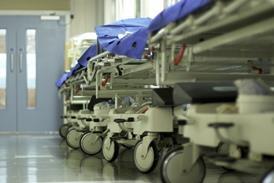The must-read stories and debate in health policy and leadership.
- Today’s resignation letter: CEO of controversial NHS property company quits
- Today’s thumbs down: Doctors’ union rejects NHSE’s PCN contract
Losing track
If there is one specialty where the recent rise in demand was predictable, it is ophthalmology. An ageing population combined with a rise in cases of diabetes meant an increase in cases of several common eye conditions was bound to happen and could have been planned for.
Many of these cases need monitoring for a patient’s lifetime to spot any signs of deterioration or when intervention is needed.
HSJ has uncovered at least 38 cases of severe harm in the past year where this has not happened properly — ie: follow-up appointments were delayed — and many more cases of moderate harm. Among them were patients who had been “lost” for years and suffered partial loss of sight as a result, while 3,384 patients had waited longer than a year past their intended date for a follow-up appointment.
Hospitals often just don’t have the capacity to offer appointments within the clinically-indicated time, but HSJ also found lots of administrative errors with bookings not being made and patients disappearing from waiting lists.
Perhaps even more worryingly, many trusts said they could not give figures for patient harms or for the number of patients who had waited past their target follow-up date. They said the data would take more than 18 hours — the limit in the Freedom of Information Act — to collate. This suggests these trusts are not on top of this problem, despite national initiatives to tackle it.
Part of the answer is likely to be more ophthalmologists, but Mike Burdon, president of the profession’s royal college, told HSJ that requests for more training posts have been turned down. He also highlighted physical constraints — hospitals don’t have the room for more consultants or the theatres for them to operate in.
Mr Burdon advocated for more community-based facilities, using a mix of healthcare professionals. Artificial intelligence could also help with some diagnoses. But, until this is widely adopted, chances are more patients will suffer avoidable harms.
A very expensive error
It has been two years since construction giant Carillion collapsed, but new information continues to emerge about the disaster and subsequent response by public officials.
The latest news, in the shape of a National Audit Office investigation, raises some big (and hitherto unanswered) questions about decisions taken by the Department of Health and Social Care.
In its haste to get building work restarted on Liverpool’s new hospital, the DHSC agreed to pay £42m to lenders as compensation for terminating the private finance initiative contract.
Officials arrived at this figure based on an estimated cost of finishing the hospital. But, just three months later, it emerged the actual cost would be much higher. This meant no compensation payment would have been necessary.
While the £42m is peanuts compared to the overall cost increases of the hospitals’ construction and maintenance, it is nevertheless a huge amount of money that has been needlessly paid to the private sector. Viewed in isolation, it is a colossal waste of taxpayers’ cash.
The fact the trust and government had to rely on information provided by the PFI lenders themselves when making the decision makes the episode seem even more unwise. The DHSC did not respond to HSJ’s questions about which officials worked on the payment.
Other questions include:
- Who signed off the £42m decision? Steve Barclay? Jeremy Hunt?
- Why were the public sector assessors allowed only limited access to the lender’s report before making an assessment?
- Why didn’t they carry out their own assessment?
- Who was responsible for overseeing work at Liverpool so shoddy that three floors had to be ripped out and redone?
The government’s take on the NAO report is it shows much of the increased cost will be borne by the private sector, with taxpayers only footing an extra 1 per cent of their initial cost.
But the bungled £42m payment exemplifies the amount of time and money wasted by these schemes, while patients face longer waits to be treated in 21st century facilities.



























No comments yet